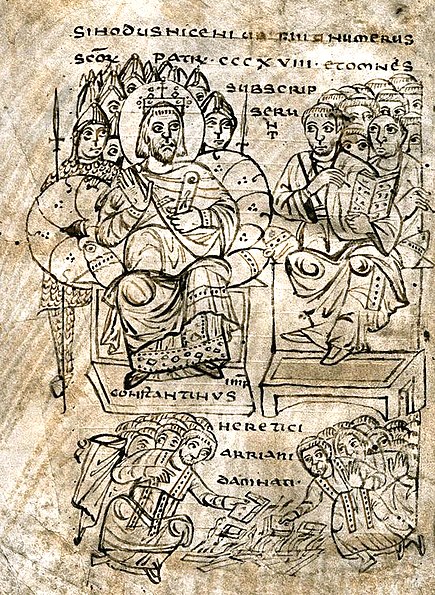Mark Goodacre has posted some comments on his blog by a couple of scholars casting doubt on how the Nag Hammadi codices were found. I’ve added to his post a fairly long comment about some of the scholarly rivalries behind all this. But you can read it there.
It led to me recall my own limited experiences with papyrologists. I’ve found a lot of them seem like jealous misers, hoarding material that should be published. There are a couple of scholars out there who have unique access to a papyrus codex of a Greek mathematical treatise.
This was sold to dealers in Switzerland along with the ps.Gospel of Judas codex, and travelled the same ruinous past. The codex was cut up into separate pages by the US art dealer Bruce Ferrini, of evil reputation these days, and sold to at least two different groups of people.
But they haven’t published it. One of them informed me graciously that he had more important things to do. That is, more important than sharing with the world the one bit of unique material that he had, which no-one could work on until he finished doing his other little tasks. Perhaps I didn’t understand him properly, but I felt exasperated at this.
Nor is this a unique occurrence. We all know how the scholars working on the Dead Sea Scrolls hoarded them, preventing any but a favoured few from accessing the material while they worked in a very leisurely way to produce editions which they expected would make their own names. The Nag Hammadi codices were monopolised by a bunch of scholars in a very similar way until James M. Robinson found a way to break the cartel and publish all the material. No doubt they would still be unpublished, but for him.
This isn’t just a modern phenomenon. Henry Tattam ca. 1840 travelled to the Nitrian desert in Egypt and purchased a huge number of Syriac texts from the monastery of St. Mary Deipara (Deir al-Suryani), which he sent to the British Library. But the curator, William Cureton, reserved what he considered to be the most interesting texts for himself to publish, which he did over the next 20 years! While this had the fortunate consequence of forcing other scholars to edit less interesting material which might not otherwise have attracted attention, it was a supremely selfish thing to do.
Selfishness, it seems, is too often a characteristic of papyrologists. While I write to all sorts of people, my attempts to communicate with papyrologists are generally futile. It is as if a clique exists, which excludes rather than includes. Yet the number of people who would like to work in the field but cannot obtain teaching posts is sufficiently large that I have met several examples at the Oxford Patristics Conference, which I tend to attend for just a single day every four years.
I remember when the late Carsten Peter Thiede proposed his idea that some fragments of the gospels at Magdalen College Oxford were in fact first century. The media were all over it, which of course was good. After all, it was media interest in the fragments of the ps.gospel of Thomas from Oxyrhynchus ca. 1900 that produced funding for the work there for several years. But the response of papyrologists was a sustained campaign of vitriol. Thiede himself was a papyrologist, and he had found a way to promote the subject to the mass media. But ranks were closed firmly against him. Any Thiede-enthusiast could expect only abuse.
It is unnecessary to consider whether Thiede’s theory was right. I think the excellent T.C.Skeat successfully showed that it was not, and why, in a model article. But who cares? He brought the wider world into contact with a discipline that almost never gets any media coverage. The coverage it does get is not of the kind that will bring in students and funding. Thiede had found a way past that — and his peers never forgave him, and the opportunity was squandered.
Since Thiede was also a Christian, I cannot help wondering whether religious animus contributed. The efforts of Paul Mirecki to use papyrological discoveries to promote his own curious views attracted no such contempt, after all. But if so, I wish that the scholars had been more professional. And they could be very unprofessional. The introduction to Graham Stanton’s Gospel Truth? in paperback contained, if memory serves me, a bitter attack on Thiede in terms that would have earned Stanton a punch in the face in any pub in Britain. How did this benefit anyone? If Thiede could persuade churches to fund an expedition to find books, as at Oxyrhynchus, wouldn’t that we wonderful? Probably any one US mid-western mega-church could easily find more funds than the whole discipline currently receives. Why turn this down?
In Egypt, under the sands, there are any number of papyrus codices as yet undiscovered. Nearly all those discovered in the last 30 years were found by peasants by accident and sold to art dealers. Many doubtless perished; although since the Cairo dealers know that these are worth real money in the west and maintain agents in rural districts who will give cash down for antiquities, most are probably saved from the cruder fate of the fireplace. But no serious scholarly effort to recover these books is being made. Meanwhile texts are hidden, or lost, or sold, while cliques squabble. It is enough to make any man despair.
We need a new movement in papyrology. We need an attitude of openness, of enthusiasm to share. We need the scholar who hides material to be treated like the one who falsifies it. We need progress!
Like this:
Like Loading...

